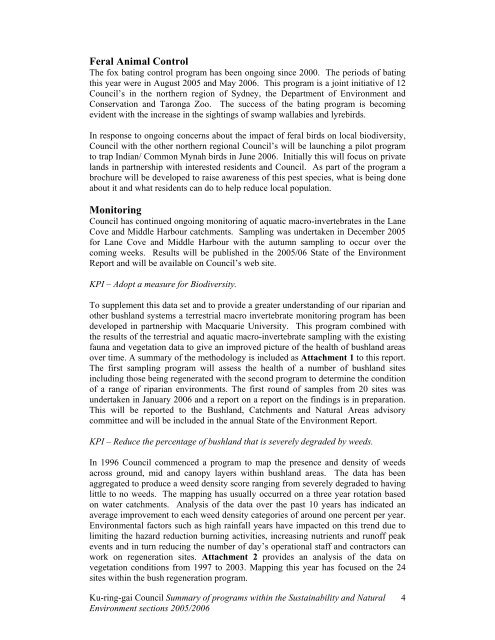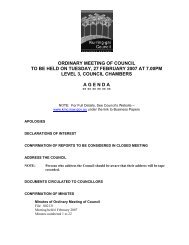ordinary meeting of council to be held on tuesday, 18 july 2006
ordinary meeting of council to be held on tuesday, 18 july 2006
ordinary meeting of council to be held on tuesday, 18 july 2006
You also want an ePaper? Increase the reach of your titles
YUMPU automatically turns print PDFs into web optimized ePapers that Google loves.
Feral Animal C<strong>on</strong>trol<br />
The fox bating c<strong>on</strong>trol program has <str<strong>on</strong>g>be</str<strong>on</strong>g>en <strong>on</strong>going since 2000. The periods <str<strong>on</strong>g>of</str<strong>on</strong>g> bating<br />
this year were in August 2005 and May <strong>2006</strong>. This program is a joint initiative <str<strong>on</strong>g>of</str<strong>on</strong>g> 12<br />
Council’s in the northern regi<strong>on</strong> <str<strong>on</strong>g>of</str<strong>on</strong>g> Sydney, the Department <str<strong>on</strong>g>of</str<strong>on</strong>g> Envir<strong>on</strong>ment and<br />
C<strong>on</strong>servati<strong>on</strong> and Tar<strong>on</strong>ga Zoo. The success <str<strong>on</strong>g>of</str<strong>on</strong>g> the bating program is <str<strong>on</strong>g>be</str<strong>on</strong>g>coming<br />
evident with the increase in the sightings <str<strong>on</strong>g>of</str<strong>on</strong>g> swamp wallabies and lyrebirds.<br />
In resp<strong>on</strong>se <str<strong>on</strong>g>to</str<strong>on</strong>g> <strong>on</strong>going c<strong>on</strong>cerns about the impact <str<strong>on</strong>g>of</str<strong>on</strong>g> feral birds <strong>on</strong> local biodiversity,<br />
Council with the other northern regi<strong>on</strong>al Council’s will <str<strong>on</strong>g>be</str<strong>on</strong>g> launching a pilot program<br />
<str<strong>on</strong>g>to</str<strong>on</strong>g> trap Indian/ Comm<strong>on</strong> Mynah birds in June <strong>2006</strong>. Initially this will focus <strong>on</strong> private<br />
lands in partnership with interested residents and Council. As part <str<strong>on</strong>g>of</str<strong>on</strong>g> the program a<br />
brochure will <str<strong>on</strong>g>be</str<strong>on</strong>g> developed <str<strong>on</strong>g>to</str<strong>on</strong>g> raise awareness <str<strong>on</strong>g>of</str<strong>on</strong>g> this pest species, what is <str<strong>on</strong>g>be</str<strong>on</strong>g>ing d<strong>on</strong>e<br />
about it and what residents can do <str<strong>on</strong>g>to</str<strong>on</strong>g> help reduce local populati<strong>on</strong>.<br />
M<strong>on</strong>i<str<strong>on</strong>g>to</str<strong>on</strong>g>ring<br />
Council has c<strong>on</strong>tinued <strong>on</strong>going m<strong>on</strong>i<str<strong>on</strong>g>to</str<strong>on</strong>g>ring <str<strong>on</strong>g>of</str<strong>on</strong>g> aquatic macro-invertebrates in the Lane<br />
Cove and Middle Harbour catchments. Sampling was undertaken in Decem<str<strong>on</strong>g>be</str<strong>on</strong>g>r 2005<br />
for Lane Cove and Middle Harbour with the autumn sampling <str<strong>on</strong>g>to</str<strong>on</strong>g> occur over the<br />
coming weeks. Results will <str<strong>on</strong>g>be</str<strong>on</strong>g> published in the 2005/06 State <str<strong>on</strong>g>of</str<strong>on</strong>g> the Envir<strong>on</strong>ment<br />
Report and will <str<strong>on</strong>g>be</str<strong>on</strong>g> available <strong>on</strong> Council’s web site.<br />
KPI – Adopt a measure for Biodiversity.<br />
To supplement this data set and <str<strong>on</strong>g>to</str<strong>on</strong>g> provide a greater understanding <str<strong>on</strong>g>of</str<strong>on</strong>g> our riparian and<br />
other bushland systems a terrestrial macro invertebrate m<strong>on</strong>i<str<strong>on</strong>g>to</str<strong>on</strong>g>ring program has <str<strong>on</strong>g>be</str<strong>on</strong>g>en<br />
developed in partnership with Macquarie University. This program combined with<br />
the results <str<strong>on</strong>g>of</str<strong>on</strong>g> the terrestrial and aquatic macro-invertebrate sampling with the existing<br />
fauna and vegetati<strong>on</strong> data <str<strong>on</strong>g>to</str<strong>on</strong>g> give an improved picture <str<strong>on</strong>g>of</str<strong>on</strong>g> the health <str<strong>on</strong>g>of</str<strong>on</strong>g> bushland areas<br />
over time. A summary <str<strong>on</strong>g>of</str<strong>on</strong>g> the methodology is included as Attachment 1 <str<strong>on</strong>g>to</str<strong>on</strong>g> this report.<br />
The first sampling program will assess the health <str<strong>on</strong>g>of</str<strong>on</strong>g> a num<str<strong>on</strong>g>be</str<strong>on</strong>g>r <str<strong>on</strong>g>of</str<strong>on</strong>g> bushland sites<br />
including those <str<strong>on</strong>g>be</str<strong>on</strong>g>ing regenerated with the sec<strong>on</strong>d program <str<strong>on</strong>g>to</str<strong>on</strong>g> determine the c<strong>on</strong>diti<strong>on</strong><br />
<str<strong>on</strong>g>of</str<strong>on</strong>g> a range <str<strong>on</strong>g>of</str<strong>on</strong>g> riparian envir<strong>on</strong>ments. The first round <str<strong>on</strong>g>of</str<strong>on</strong>g> samples from 20 sites was<br />
undertaken in January <strong>2006</strong> and a report <strong>on</strong> a report <strong>on</strong> the findings is in preparati<strong>on</strong>.<br />
This will <str<strong>on</strong>g>be</str<strong>on</strong>g> reported <str<strong>on</strong>g>to</str<strong>on</strong>g> the Bushland, Catchments and Natural Areas advisory<br />
committee and will <str<strong>on</strong>g>be</str<strong>on</strong>g> included in the annual State <str<strong>on</strong>g>of</str<strong>on</strong>g> the Envir<strong>on</strong>ment Report.<br />
KPI – Reduce the percentage <str<strong>on</strong>g>of</str<strong>on</strong>g> bushland that is severely degraded by weeds.<br />
In 1996 Council commenced a program <str<strong>on</strong>g>to</str<strong>on</strong>g> map the presence and density <str<strong>on</strong>g>of</str<strong>on</strong>g> weeds<br />
across ground, mid and canopy layers within bushland areas. The data has <str<strong>on</strong>g>be</str<strong>on</strong>g>en<br />
aggregated <str<strong>on</strong>g>to</str<strong>on</strong>g> produce a weed density score ranging from severely degraded <str<strong>on</strong>g>to</str<strong>on</strong>g> having<br />
little <str<strong>on</strong>g>to</str<strong>on</strong>g> no weeds. The mapping has usually occurred <strong>on</strong> a three year rotati<strong>on</strong> based<br />
<strong>on</strong> water catchments. Analysis <str<strong>on</strong>g>of</str<strong>on</strong>g> the data over the past 10 years has indicated an<br />
average improvement <str<strong>on</strong>g>to</str<strong>on</strong>g> each weed density categories <str<strong>on</strong>g>of</str<strong>on</strong>g> around <strong>on</strong>e percent per year.<br />
Envir<strong>on</strong>mental fac<str<strong>on</strong>g>to</str<strong>on</strong>g>rs such as high rainfall years have impacted <strong>on</strong> this trend due <str<strong>on</strong>g>to</str<strong>on</strong>g><br />
limiting the hazard reducti<strong>on</strong> burning activities, increasing nutrients and run<str<strong>on</strong>g>of</str<strong>on</strong>g>f peak<br />
events and in turn reducing the num<str<strong>on</strong>g>be</str<strong>on</strong>g>r <str<strong>on</strong>g>of</str<strong>on</strong>g> day’s operati<strong>on</strong>al staff and c<strong>on</strong>trac<str<strong>on</strong>g>to</str<strong>on</strong>g>rs can<br />
work <strong>on</strong> regenerati<strong>on</strong> sites. Attachment 2 provides an analysis <str<strong>on</strong>g>of</str<strong>on</strong>g> the data <strong>on</strong><br />
vegetati<strong>on</strong> c<strong>on</strong>diti<strong>on</strong>s from 1997 <str<strong>on</strong>g>to</str<strong>on</strong>g> 2003. Mapping this year has focused <strong>on</strong> the 24<br />
sites within the bush regenerati<strong>on</strong> program.<br />
Ku-ring-gai Council Summary <str<strong>on</strong>g>of</str<strong>on</strong>g> programs within the Sustainability and Natural<br />
Envir<strong>on</strong>ment secti<strong>on</strong>s 2005/<strong>2006</strong><br />
4
















